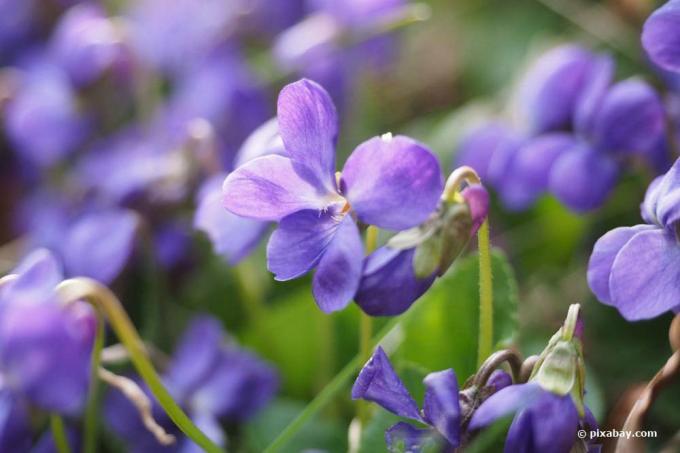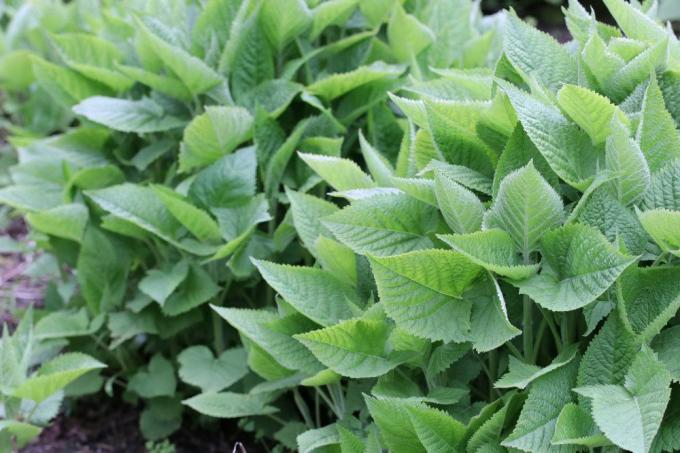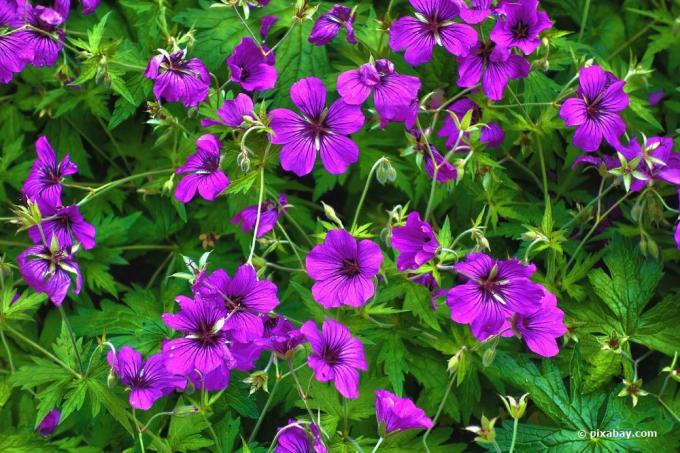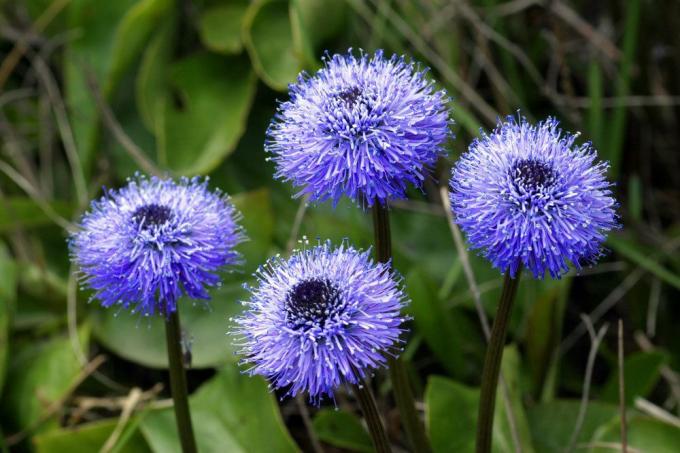
table of contents
- Plant the zinc tub
- drainage
- Rustic spring bed
- Forest-like bathtub
- Fragrant violets
- Common loosestrife
- Sticky sage
- Garlic mustard
- Chickweed
- Zinc tub with colorful summer flowers
- Blood cranesbill
- Real ball flower
- Big snapdragon
- Musk Mallow
- Orange-red hawkweed
- Variety of herbs
Zinc tubs are very popular in the garden because they are perfect as a container for planting colorful flowers and herbs. So you can create a varied bed in the smallest of spaces that blooms from spring to autumn. In addition to the selection of suitable species, drainage is important so that the plants do not sink into the water.
Plant the zinc tub
Each plant can be placed in a tub if you consider the different needs of the species. Select the plants according to their habitats. If you want to create a natural planting, you can orientate yourself on the flora in forests, on roadsides or in meadows.
Zinc tubs come into their own particularly well when you plants of different heights composed with red, yellow and blue flowers. The vessels are not only suitable for shallow roots. Deep-rooted species find enough space to grow in high tubs. Combine species with different root systems to make the most of the space.
Checklist for planting in a bathtub:
- Select category: early bloomers, summer flowers, forest plants, herbs
- Check light requirements: shade, penumbra, or sun
- Note soil requirements: nutrient-rich or lean
- Consider water requirements: dry, fresh or damp
tip: Tubs with natural greenery are a valuable contribution to nature conservation in your own garden and are easy to care for. Plant the vessel with local flowers and just watch how the arrangement evolves every year.
drainage
The drainage is of great importance, because most plants do not tolerate waterlogging. If you leave the zinc tub outdoors all year round, rainwater will quickly collect on the ground. Drill holes in the bottom of the tub to allow rainwater to drain:
- Use metal drills for finger-sized holes
- hammer smaller holes with a thick nail
- alternatively use a zinc tub with a drain
To prevent the holes from clogging, you should spread pottery shards on the ground before planting. Alternatively, shards from ceramic plates or expanded clay are suitable. If you don't have a suitable drill, you can cover the bottom of the tub with larger stones or a layer of gravel. This creates an earth-free zone in which water can temporarily accumulate and, when exposed to sunlight, pulls into the substrate from below. This method is only recommended if the zinc tub is not directly in the open air.
Rustic spring bed
Onion plants are popular when designing tub beds. The tubers are planted in autumn. With the appropriate winter protection, the vessels spend the winter outdoors. When the temperatures rise in spring, the rhizomes sprout. You can put almost all of the early flowering bulb plants together in one tub, as most species have similar needs. They thrive on fresh to moist soils in a partially shaded location and like a moderately nutrient-rich subsoil. The arrangement looks particularly beautiful when you combine different colors and shapes:
- Low tulip (Tulipa humilis) with pale pink flowers and a yellow center
- Yellow daffodil (Narcissus pseudonarcissus) as a tall eye-catcher
- Small snowdrop (Galanthus nivalis) with double flowers
- Winterling (Eranthis hyemalis) with a particularly harmonious habit
- Wood anemone (Anemone nemorosa) than more tender Ground cover
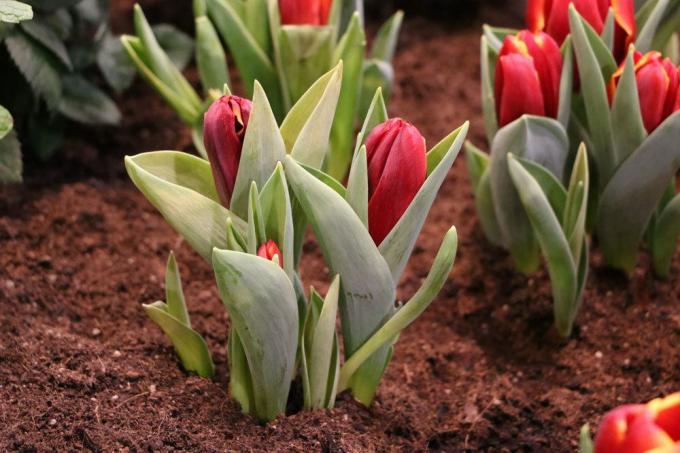
tip: So that the soil does not look too bare in the early flowering bed, you can cover the substrate with a thick layer of moss.
Forest-like bathtub
The herbaceous layer of the forests is characterized by plants that prefer fresh to moist conditions and require partially shaded light conditions. A nutrient-rich substrate guarantees them optimal growth conditions. Many species are not only pretty to look at, but can also be used in the kitchen.
Fragrant violets
The scented violet (viola odorata) impresses with intense purple flowers that appear between March and April. They exude a sweet scent that attracts wild bees, butterflies and bumblebees. Because of the raspberry-like taste, the flowers are often used for desserts. Scented violets prefer a light to partially shaded place. You feel under higher Perennials especially well. Viola odorata grows under deciduous shrubs, which is why the species thrives particularly well under fruit trees. When planting, make sure that the larger plants are not too close together.
Common loosestrife
With its striking yellow flowers that shine between June and August, the Loosestrife (Lysimachia vulgaris) a perfect addition to the mini forest bed. In nature, the plant grows in sparse places in forests, but also on moist meadows, in swampy woods and on the banks of streams. It is enough if you put a plant in the background of the zinc tub. Lysimachia vulgaris develops underground runners and thus spreads rapidly. The species can pollinate itself and reproduces via seeds. As a perennial species, the yellow loosestrife adorns the plant arrangement for many years.
Sticky sage
This sage plant is one of the taproots that are suitable for planting the center and background of the zinc tub. The sticky flowers give off a sweet scent and serve as a source of nectar for bumblebees and wild bees. Salvia glutinosa is a typical species found in damp alluvial forests or ravines. It grows on the edge of the forest and has no problems with shady conditions. This is how this species differs from its relatives:
- Salvia officinalis needs stony and dry substrate
- Salvia pratensis loves sunny locations and dry, nutrient-rich soils
- prefers semi-arid conditions and sunny locations Salvia nemorosa
- Salvia sclarea grows in the sun in poor soil
Garlic mustard
This penumbra plant likes nitrogen-rich soils, which is why the garlic mustard (Alliaria petiolata) is often found next to nettles. It grows naturally under hedges and bushes or on paths and walls. The herbaceous plant feels particularly good on fresh clay soils. The white flowers are an important food source for various species of butterflies. The crucifer is therefore ideal for creating a butterfly bed.
Chickweed
The carnation plant is a typical herb on nutrient-rich substrates. Therefore, the chickweed (Stellaria media) spreads preferentially on arable soils with fresh conditions. It is often called weed Stellaria media is particularly useful in the bathtub. The plant develops a dense carpet and covers the substrate with its creeping runners. It serves as protection against evaporation during the hot summer months. In winter, the dried up shoots and leaves act as natural insulation against the cold.

tip: If the plant overgrows, cut back the shoots vigorously. They are a refreshing ingredient for salads with a corn-like flavor.
Zinc tub with colorful summer flowers
Flowers from flowering meadows prefer sunny conditions. They grow in poor to moderately nutrient-rich soils that provide dry or fresh conditions. With their abundant variety of flowers, flowers put you in a good mood. At the same time, they serve as an important supplier of food. They produce pollen and nectar, so that the planted zinc tub becomes a magnet for butterflies, wild bees and bumblebees during the summer.
Blood cranesbill
Between May and September this cranesbill transforms (Geranium sanguineum) turns the garden into a shining sea of flowers. Because of the long creeping root system, the species is suitable for planting large vessels. For the blood cranesbill to thrive, the soil must be loose, nutrient-poor and dry. The species occurs in sparse forests. The tolerance of different light conditions makes the plant the perfect plant for the zinc tub. You don't have to commit yourself and you can also mix plants with different lighting requirements. Orientate yourself to the natural plant communities in which the blood cranesbill grows. The characteristic species of these communities have similar location requirements:
- Colorful iris thrives in sun and partial shade
- Big anemone prefers light conditions
- Mountain aster loves sunny locations
Real ball flower
When looking at this blue beauty, nobody thinks that the globular flower (Globularia bisnagarica) is related to the ribwort. The plantain plant colonizes semi-arid to dry meadows and bushes. It is perfect for creating a natural setting in the zinc tub. The plant comes into its own particularly well in sunny locations. The real globe flower harmonizes with low-growing flowers that develop yellow petals.
Big snapdragon
In nature this species grows in crevices in the rock. It has adapted to dry and nutrient-poor soils and grows splendidly in sunny locations. The flowers are reminiscent of little mouths. They produce sweet nectar and attract bumblebees and wild bees. Even if the plant is often cultivated as an annual, it is suitable for planting zinc tubs. If you leave the vessel to its own devices, the snapdragon (Antirrhinum majus) will sow itself and grow anew every year. Provided that it is not displaced by competitive plants.
Musk Mallow
The strikingly large flowers of the musk mallow (Malva moschata) are particularly effective in the tub between low plants. Soils rich in nutrients shape the natural habitat. The plant particularly likes nitrogen-rich soils that are moderately fresh. It is the ideal summer bloomer for plant arrangements with a meadow character. The more sun the herbaceous plant gets, the more profuse it will bloom.
Orange-red hawkweed
Hobby gardeners appreciate the wild beauty because of its magnificent flowers, which give the bed a contrasting color. The perennial, with the botanical name Hieracium aurantiacum, is ideal as a ground cover for planting in larger zinc tubs in which two to three sun-hungry species grow. However, do not put too many species next to the hawkweed to avoid competition. A nutrient-poor substrate offers the daisy family optimal growth conditions. Herbs and flowers can also be harvested. They taste like bitter chocolate.
Variety of herbs
Both local herbs and Mediterranean plants are suitable for planting the zinc tub. Many aromatic plants prefer a dry one floor, which is why you need to ensure good drainage. You can turn the tub into a pure herb bed, or the herbs into Mixed cultures plant. In this way you create a small bed that can then be harvested at different times of the year. Choose plants that match:
- basil does well next to tomatoes, rosemary and paprika
- Oregano goes well with seasoned sage, savory and thyme
- Parsley grows between Strawberries and onions
- lavender goes well with thyme and sage


